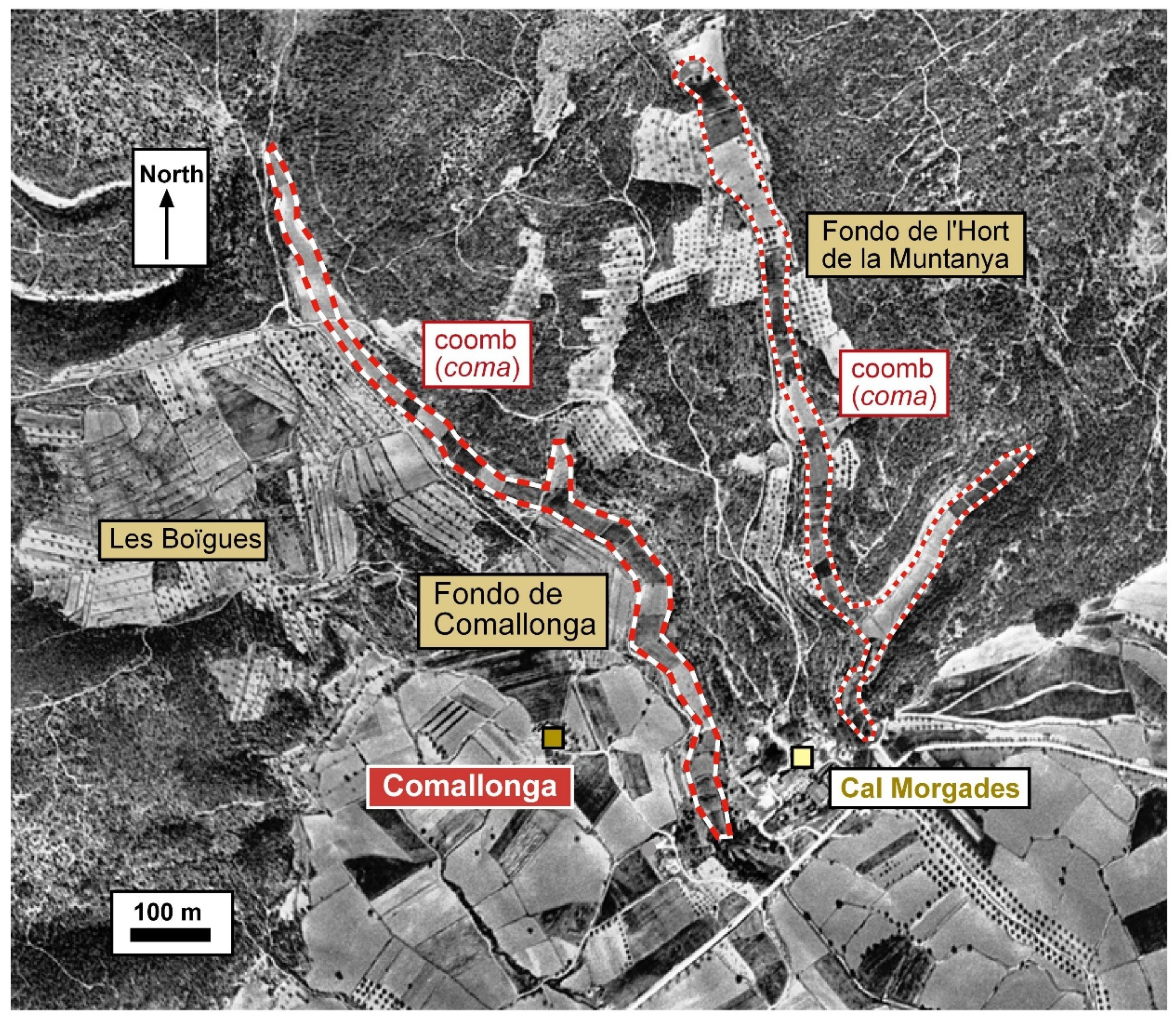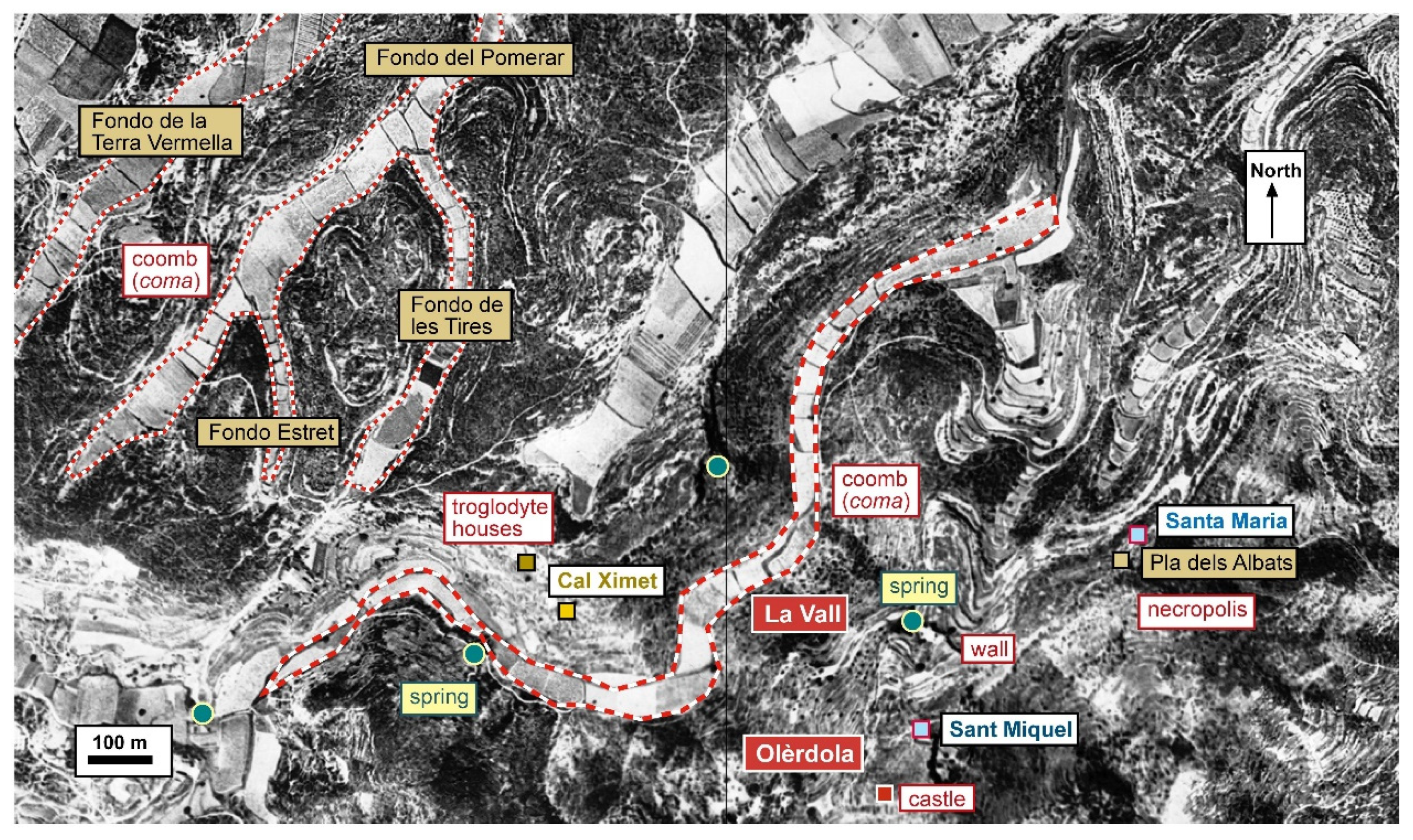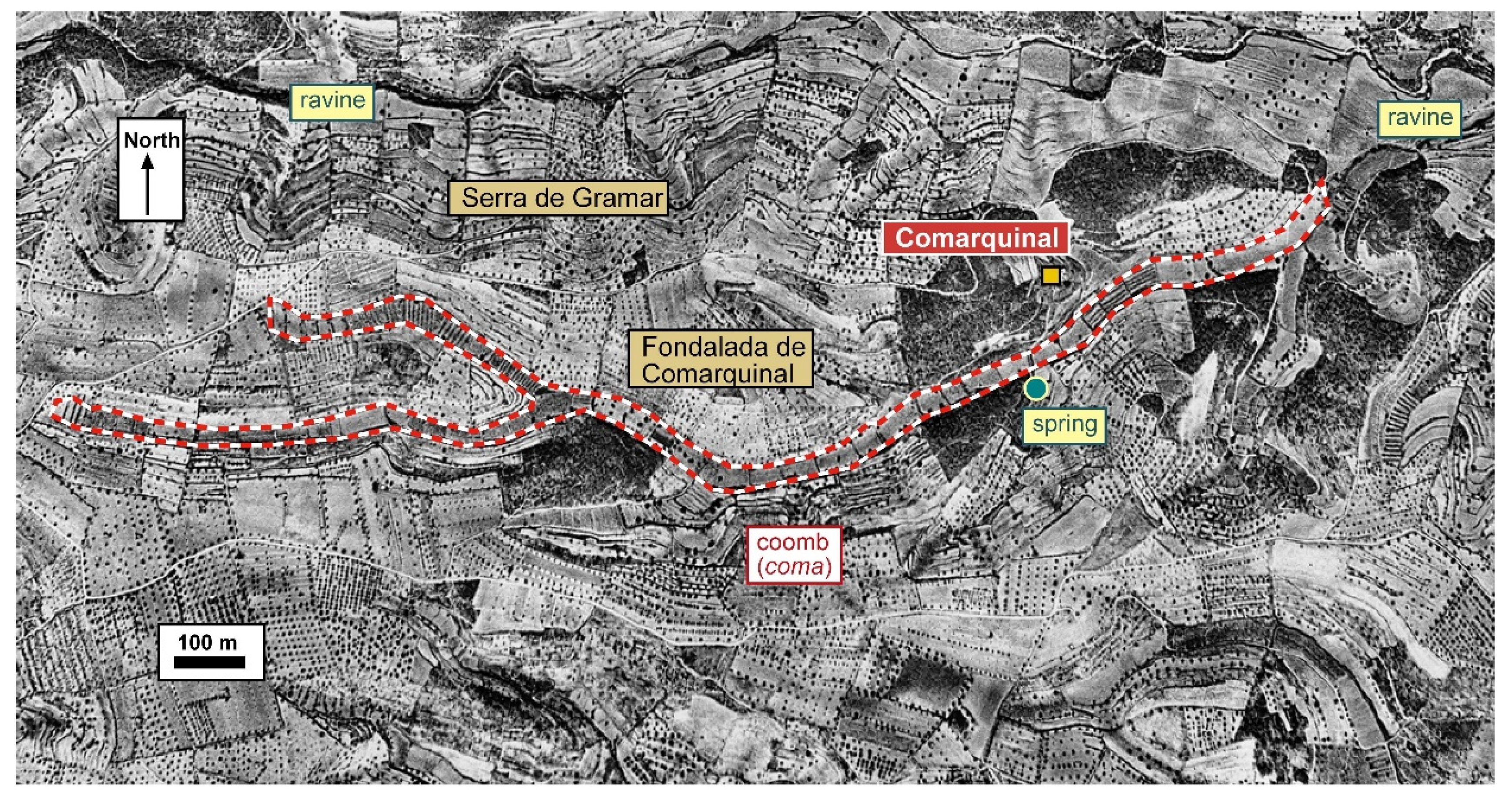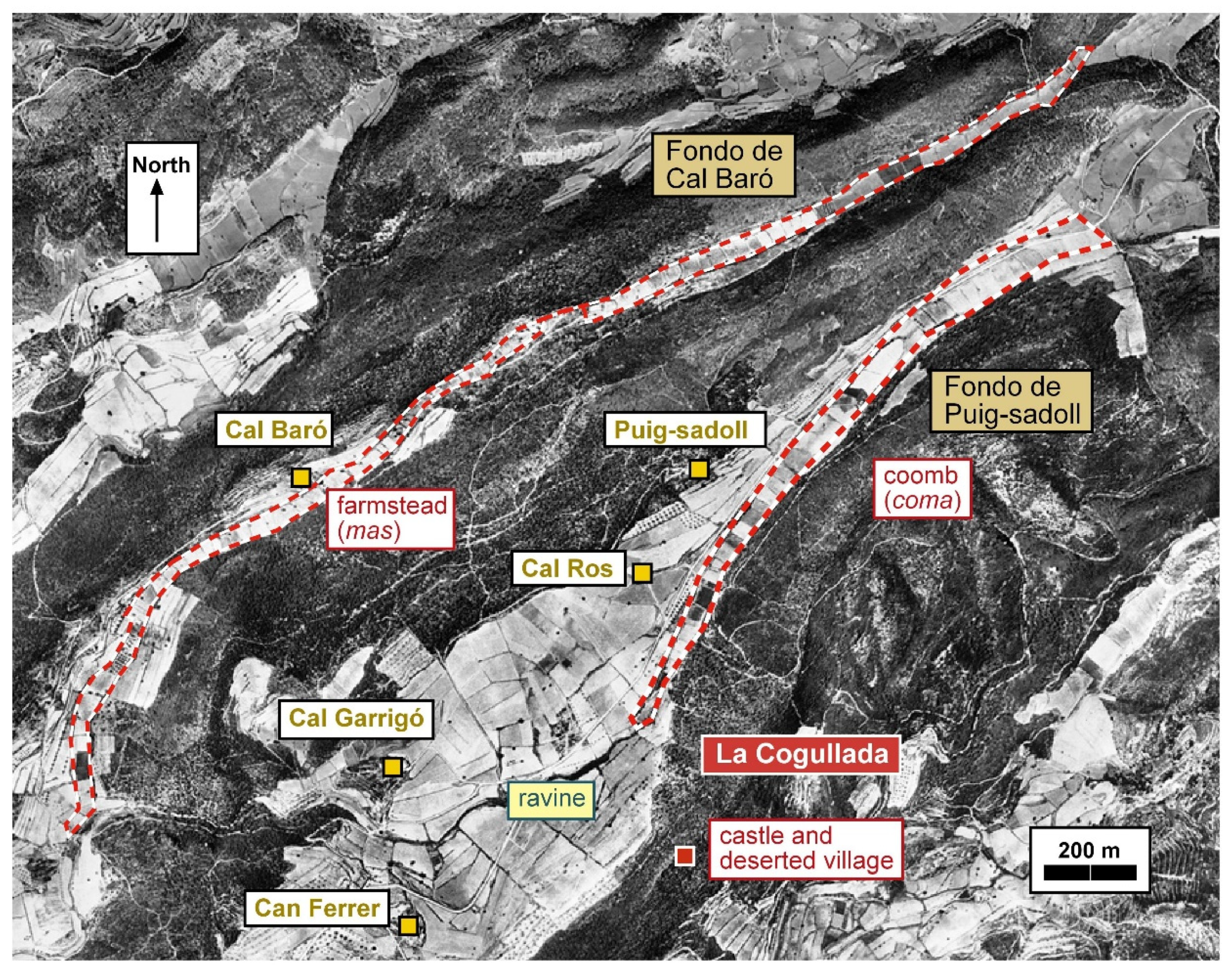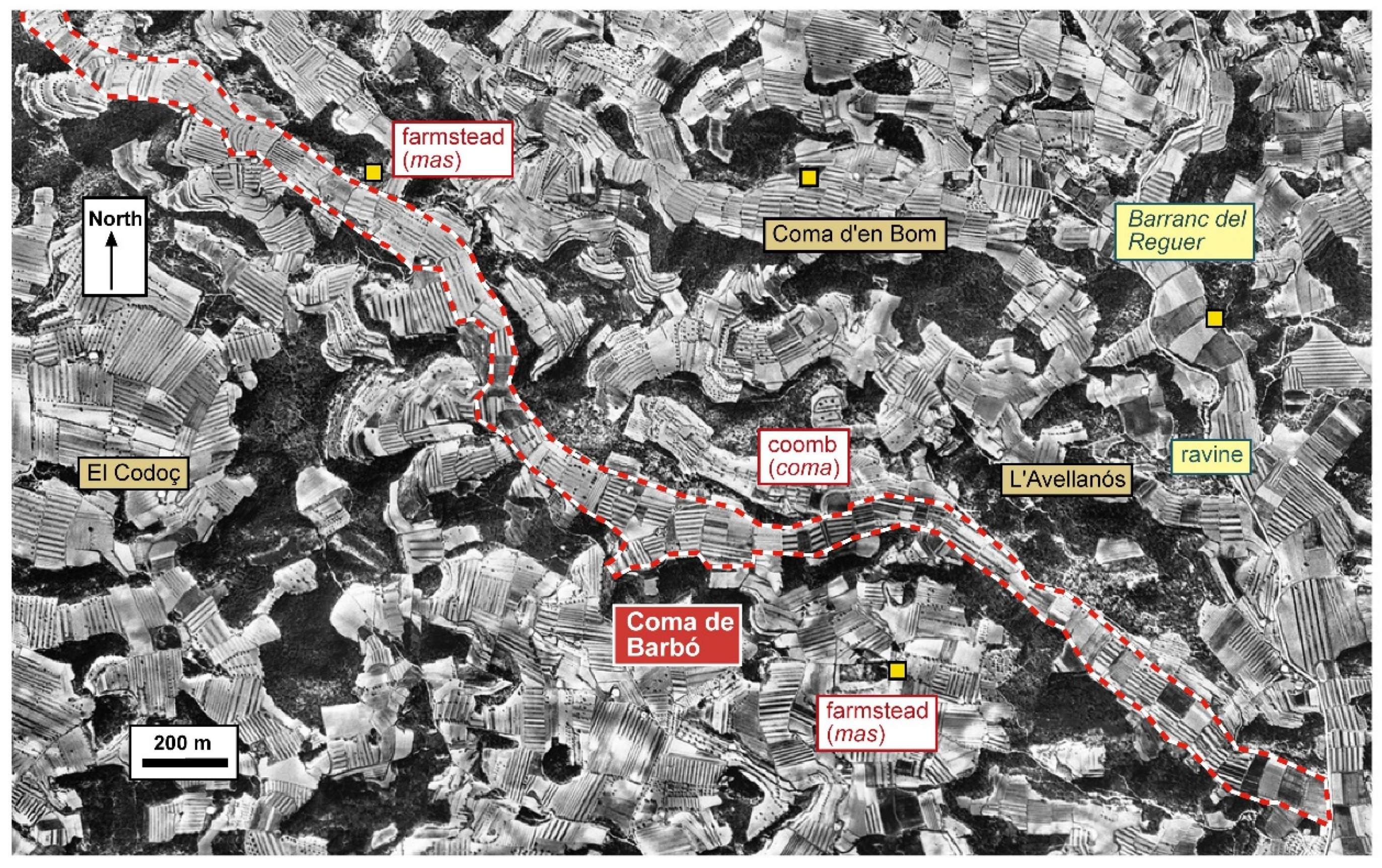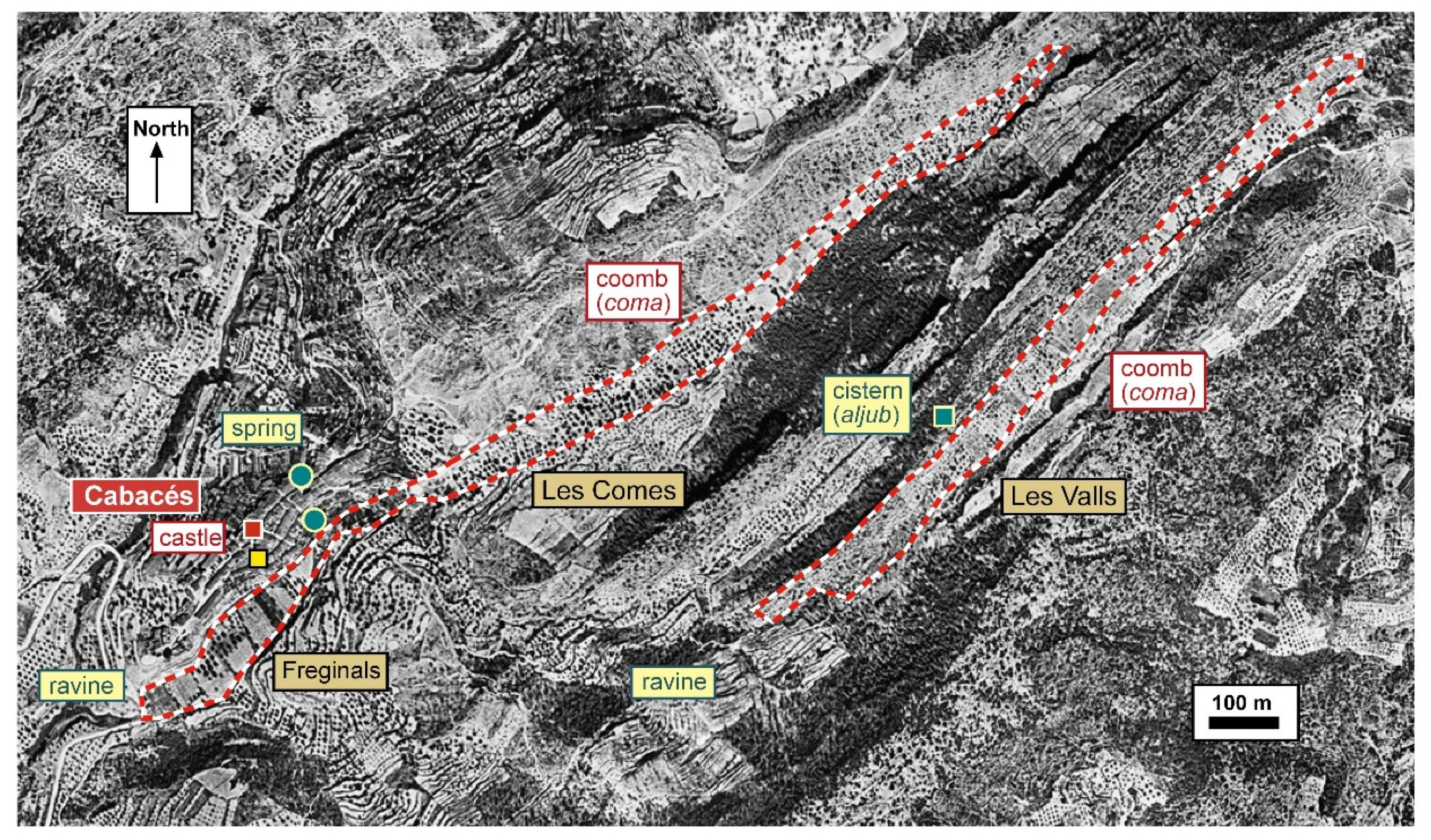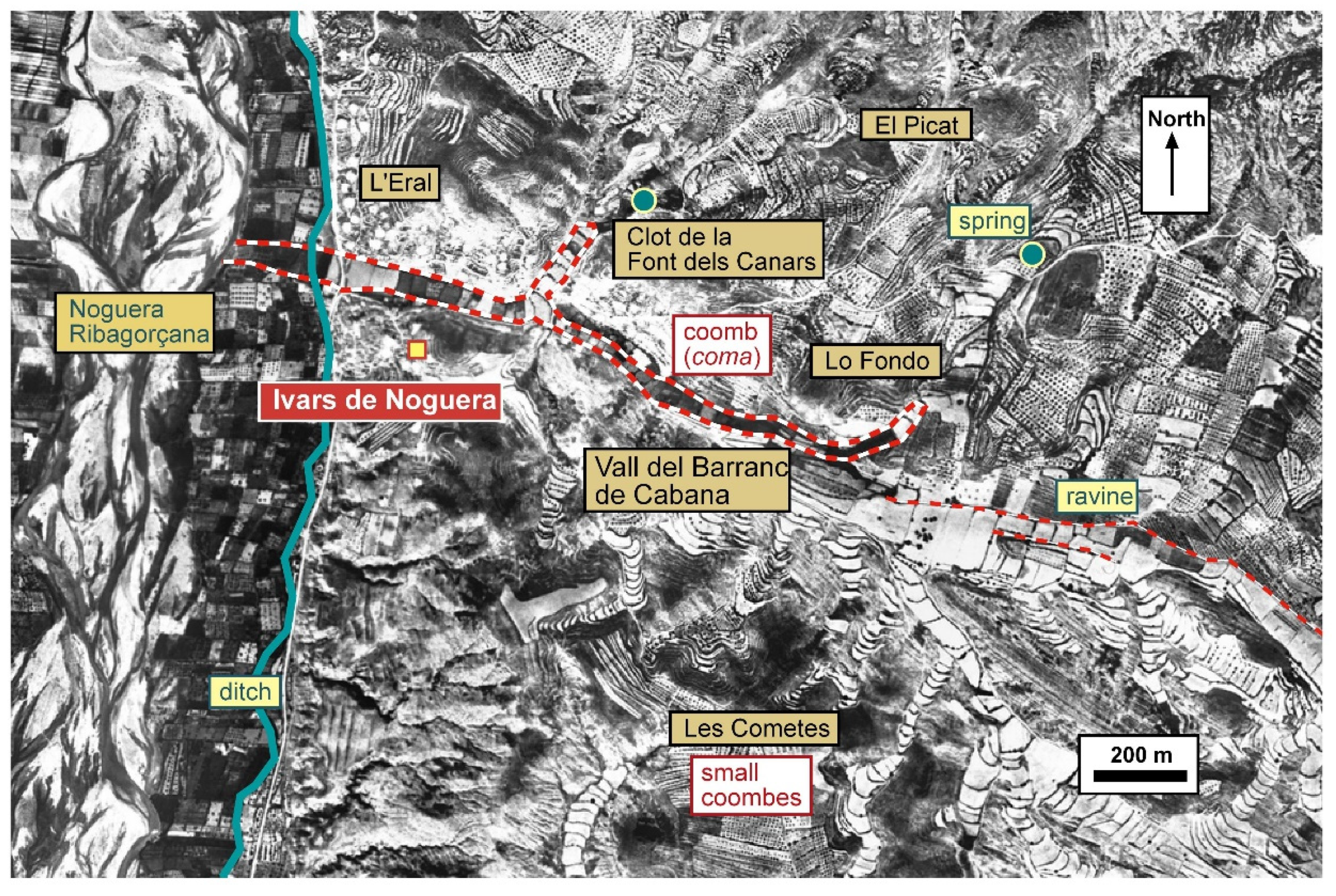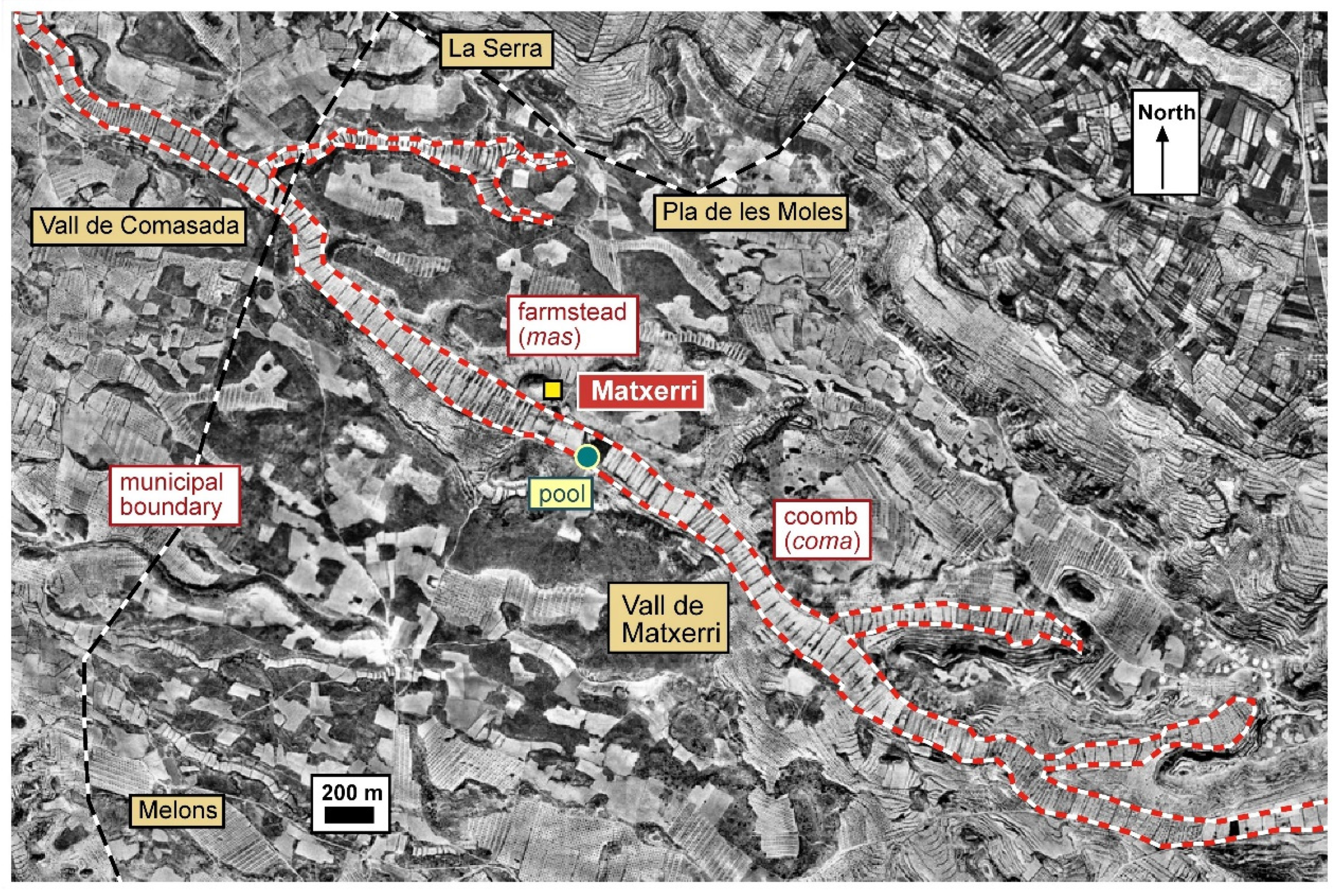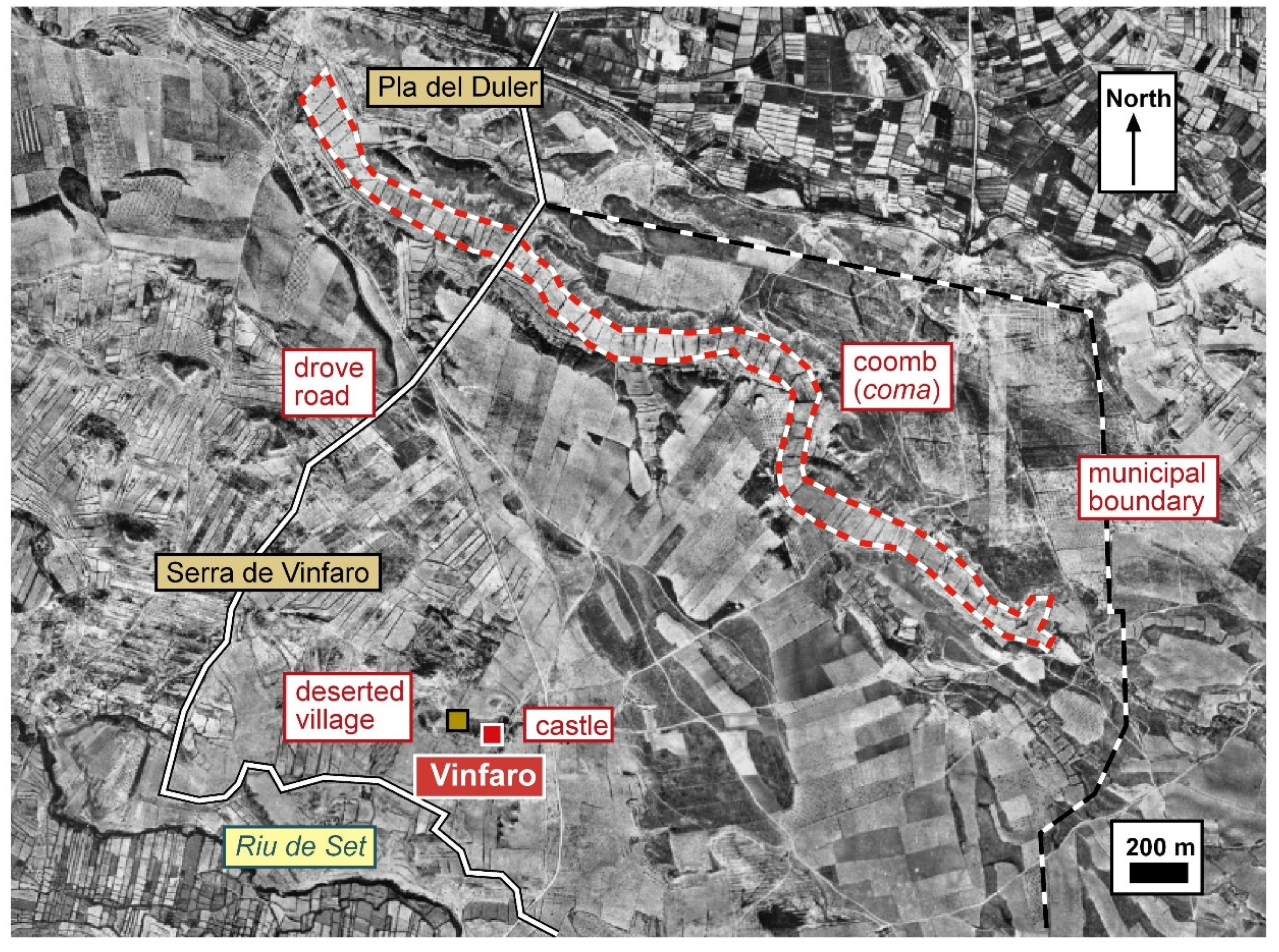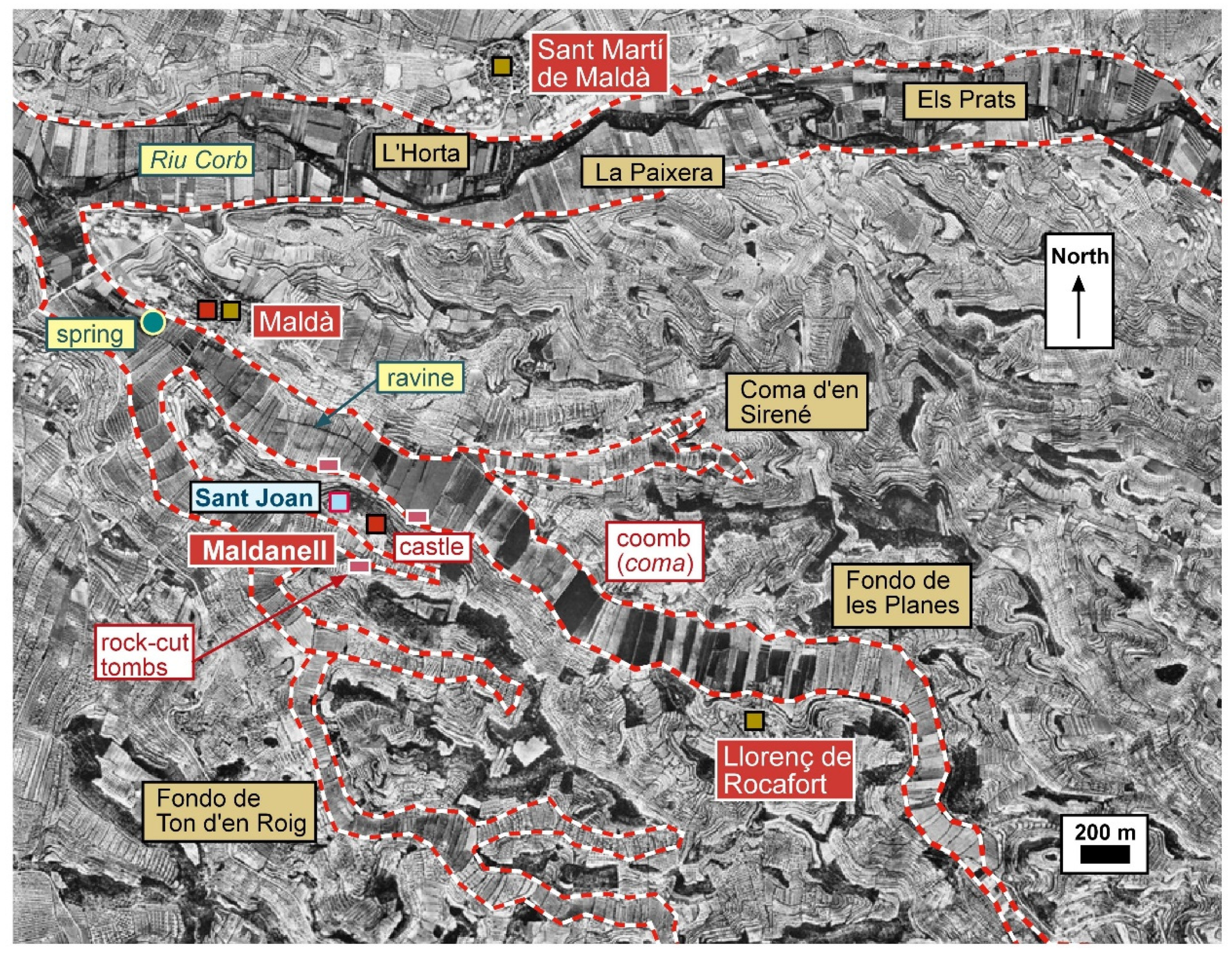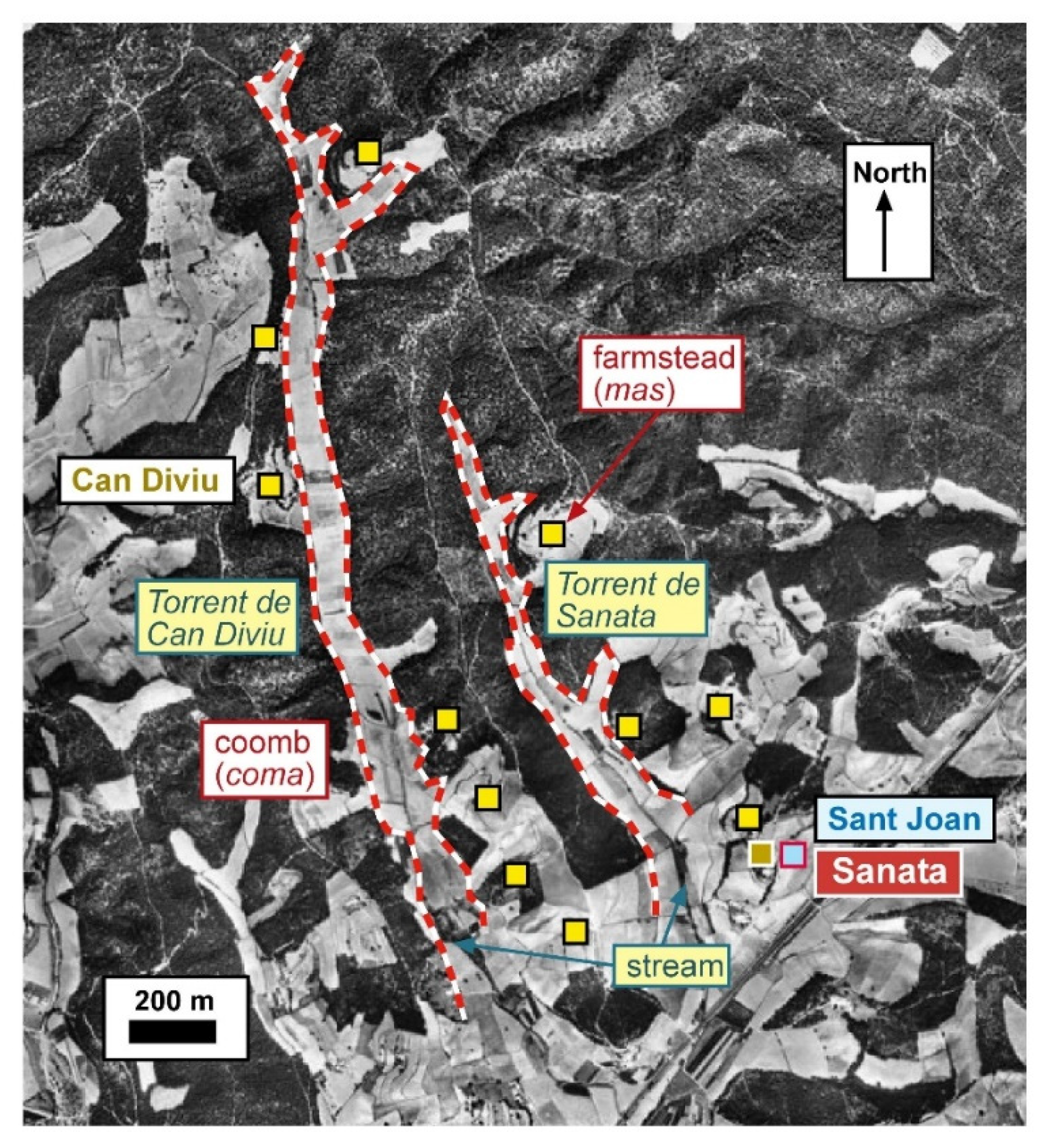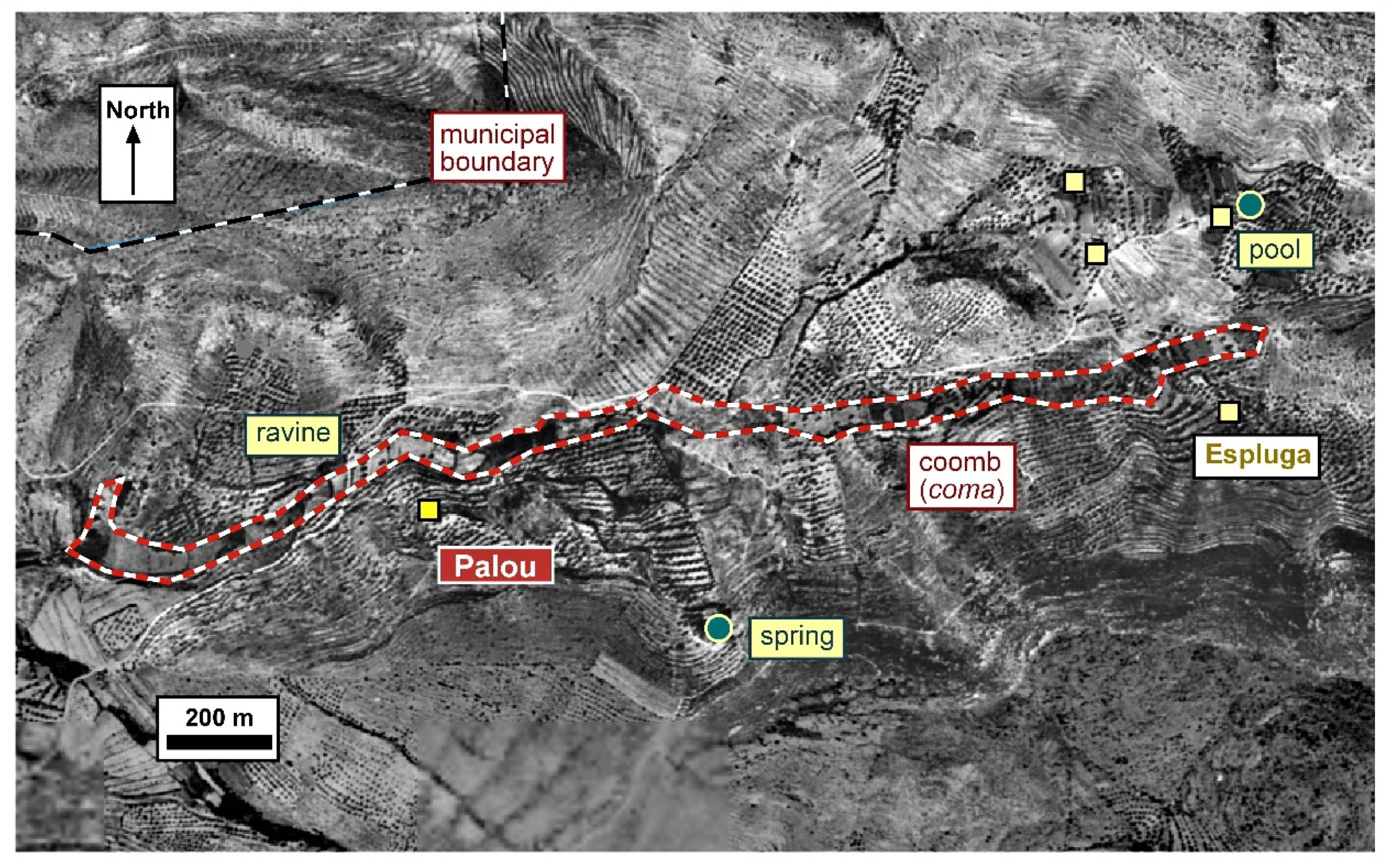Submitted:
06 July 2023
Posted:
07 July 2023
You are already at the latest version
Abstract
Keywords:
1. Introduction
2. Coombs (comes): Components of the Landscape
2.1. What Is a Coomb (coma) and When Was it Created
2.2. Territories and Places Studied
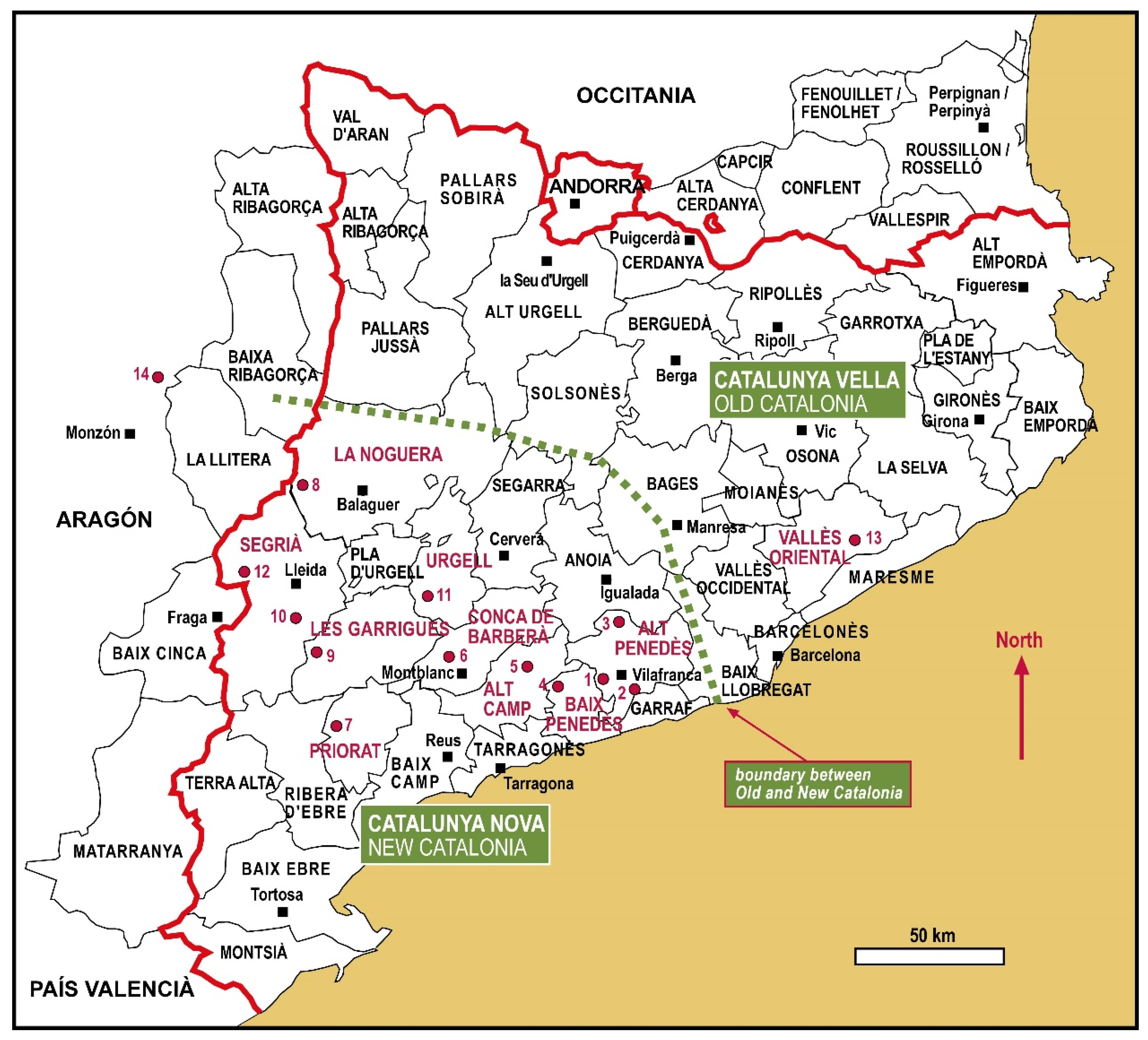
2.2.1. Penedès Region
-
Comallonga (Castellví de la Marca, Alt Penedès) (Figure 2). Comallonga is a coomb, a strip of cultivated land that stretches along a valley floor [38] (pp. 495–540). This particular coomb is 1.16 km long and covers an area of 3 hectares. Notably, there is a 50-m elevation difference between the highest and lowest points. In addition, the coomb is divided into parades (plots of land), with sizes of about 40 meters long and 25 to 35 meters wide (corresponding to the width of the coomb). At the lower end of the coomb, there is a farmstead still known as Comallonga. In the southern sector, flatter lands emerge, where traces of potential fossilized remains from the orthogonal land division during the Roman period can be observed.
-
La Vall near Olèrdola (Olèrdola, Alt Penedès) (Figure 3). Next to the Olèrdola site [39], approximately 300 m to the north, lies a coomb known as Fondo de la Vall. It stretches for 2.2 km with a width ranging from 35 to 45 m, covering an area of 7.7 hectares. In close proximity to it are the Balmes de Cal Ximet, which contain remains of a troglodyte habitat dating back to the early Middle Ages [40,41]. On the opposite side of the coomb is a spring called Font de l’Avellaner. Moving further to the north, there are additional coombs, perhaps less fertile extending over approximately 23.7 hectares with a total length of about 4.3 km. These coombs have various names such as Fondo de la Terra Vermella (red earth), Fondo del Pomerar (apple orchard), Fondo Estret (narrow) or Fondo de les Tires (of the strips). Olèrdola is a well-documented place from the tenth century featuring houses, a castle, ancient walls, and several churches.
-
Comarquinal (Sant Quintí de Mediona, Alt Penedès) (Figure 4). Located at the north-eastern end of the Sant Quintí de Mediona municipality, there is a long coomb known as Comarquinal or Fondalada de Comarquinal. It stretches for approximately 2 km, covering an area of 7.0 hectares. On the north side, there is an additional arm of the coomb spanning 1.6 hectares. The western end is situated at an altitude of 383 m, with a height difference of 83 m. The plots of land, known as partides, are about 30 m wide and 60 m long. Notably, the Comarquinal farmhouse is located about 60 m away from the top of the coomb. On the opposite side of the coomb, there is a spring called Font de la Mata. This place name originates from Coma Arquinald, the coomb of a man who likely settled there around the year 1000.
-
La Cogullada (El Montmell, Baix Penedès) (Figure 5). Adjacent to the Ferrer de la Cogullada farmstead, there is a coomb measuring 1.6 km in length and covering 8.8 hectares [38] (pp. 520–524). There is an elevation difference of approximately 82 m, and it is named Fondo de Puig-sadoll. The Cal Garrigó stream flows nearby. The land within several of the plots, known as parades, has a width of about 40 meters and a length ranging from 25 and 40 m. A little further north, at a distance of approximately 600 m, there is another coomb that is even longer (3 km) and has a larger area (13.3 hectares). In this case, the elevation difference is 184 meters, and it is called Fondo de Cal Baró (located in the municipality of Aiguamúrcia). Currently, these coombs are likely associated with several farmsteads.
2.2.2. Region of Tarragona, Conca de Barberà and Priorat
-
Les Planes (Cabra del Camp and Pla de Santa Maria, Alt Camp) (Figure 6). To the west of the Gaià river, there is a slope furrowed by a path that runs from Sant Pere de Gaià to Cabra del Camp. This road is ancient, existing since at least the Roman period [38] (pp. 781–789). A section of this road aligns with the municipal boundary. On this mountainside, we see at least three coombs that converge at the lower end. The western coomb covers an area of 7.5 hectares, the central coomb also spans approximately 7.5 hectares, the eastern coomb measures 6.0 hectares. Additionally, the southern end extends for about 5.9 more hectares. The total length of the central coomb is approximately 1.6 km, with an elevation difference of about 56 m between the upper and lower ends. The plots of land within this coomb are about 50 to 60 meters long. Currently, scattered farmhouses can be seen on this land, possibly built during the late Middle Ages, along with dispersed livestock enclosures.Figure 6. Aerial photograph of Les Planes (Cabra del Camp and Pla de Santa Maria, Alt Camp), depicting the boundaries of the coombs. The path that connects Sant Pere de Gaià and Cabra del Camp has been marked.Figure 6. Aerial photograph of Les Planes (Cabra del Camp and Pla de Santa Maria, Alt Camp), depicting the boundaries of the coombs. The path that connects Sant Pere de Gaià and Cabra del Camp has been marked.
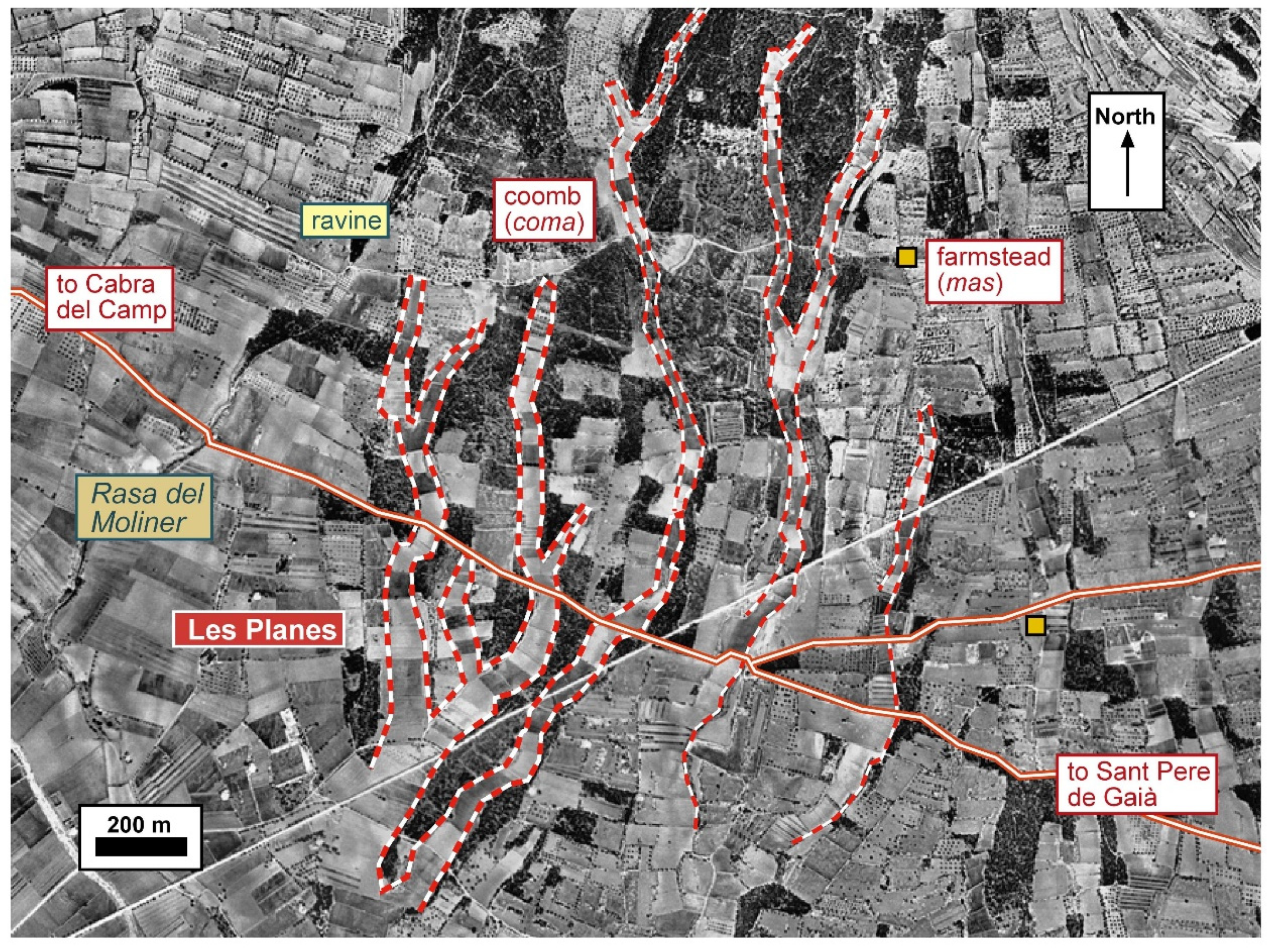
-
Coma de Barbó (L’Espluga de Francolí, Conca de Barberà) (Figure 7). Located north of L’Espluga de Francolí municipal district, we find Coma de Barbó, one among several coombs in this area. This coomb is notably long, spanning approximately 4.2 km, with a surface area of 38.3 hectares. There is an elevation drop of about 162 meters between the two ends of the coomb, the upper end near L’Argullol, and the lower end at Barranc del Reguer. It has a width of approximately 70 m, and the different plots of land within it range from 40 to 70 m. Nearby, we currently see several scattered farmhouses, possibly created in the later medieval centuries. As we will see, when this territory was conquered around the eleventh century, this coomb and others already existed and were appreciated by the newcomers.
-
Cabacés (Priorat) (Figure 8). Adjacent to the village of Cabacés is the small valley known as Les Comes. It stretches for 1.7 km next to the village, covering an area of 8.1 hectares with a width of approximately 60 m. The village was built after the county’s conquest, next to a castle. However, it certainly existed long before that. The earliest preserved documents mention Abincabacer, which reveals both an Arabic and a Mozarabic name [22] (vol. 3, p. 158). About 350 m further east, there is another coomb called Les Valls, which measures 1 kilometer in length and occupies an area of 3.7 hectares.
2.2.3. Region of Lleida
-
Ivars de Noguera (La Noguera) (Figure 9). To the north of the village, there is a coomb known as Vall del Barranc de Cabana [45]. It stretches for 1.8 km and covers an area of 9.8 hectares. Additionally, there is a branch extending northward, spanning 1.1 hectares. In the westernmost sector, below the town and closer to the Noguera Ribagorçana river, the width is greater (approximately 50 meters), suggesting that it may have been used for irrigation purposes. The plots of land within this coomb are about 40 meters long. Moving eastward, the coomb becomes narrower (around 30 m). The elevation difference in level is not significant, with approximately 62 m between the eastern end and the river.
-
Matxerri (Castelldans, Garrigues) (Figure 10). To the west of Castelldans lies the Mas de Matxerri [7]. Below the farmhouse, there is a wide coomb that stretches for 5.8 km from the municipal boundary in the west to the outskirts of Castelldans. It covers an area of 79.1 hectares. If we continue west into the current municipal districts of Artesa de Lleida, it extends another 4.8 km with an additional 40.8 hectares. The total difference in elevation is 133 m (81 m within the municipality of Castelldans alone). The coomb’s width is approximately 110 m, and the plots of land are about 70 m long. It should be noted that the terrain is arid. Next to the Mas de Matxerri, there is a water pool. While the coomb within the area of Castelldans is called Vall de Matxerri, in the western sector, it is known as Comasada. It should be noted that about 2 km south of the Matxerri valley, there is the Melons valley, a very long coomb spanning over 9 km. The names "sada" and "melons" both have Latin origins, referring to cultivated places and locations where badgers were found [22] (vol. 6, p 464; vol. 5, p. 247). This linguistic fact is not only of interest but also suggests continuity in population and the use of these valleys since at least the end of the Roman era.
-
Vinfaro (Alfés, Segrià) (Figure 11). To the north of the Vinfaro district, a medieval village that was abandoned in modern times, there is a wide coomb extending for 2.8 km within the municipality. It covers an area of 27.8 hectares of dry land with a slight difference in elevation of approximately 26 m. The coomb’s width is 100 m, and the plots of land, without stone borders, range in length from 40 to 60 m. To the south, near the Riu de Set River, there is another smaller coomb. The Vinfaro district was primarily dry land and the rearing of cattle must have been significant, as evidenced by the presence of a drove road and the place name Pla del Duler (the duler was the shepherd in charge of the dula or herd of grazing animals).
-
Maldanell (Maldà, Urgell) (Figure 12). In the municipality of Maldà, there was a castle and a settlement known as Maldanell, or “little Maldà”. Below Maldanell is a small watercourse and a very extensive coma, referred to as Fondo de les Planes [46] (p. 97) in certain areas. It stretches for 5.2 km, with a difference in elevation of 82 m. The total area is approximately 104 hectares although it is unclear whether this resulted from expansions. This coomb is wider and more fertile than the previously mentioned ones. The land plots are estimated to be about 170 m in width, corresponding to the coomb’s width, but they are not very long, ranging from 30 to 60 m. It should be noted that further north, between Maldà and Sant Martí de Maldà, the Riu Corb can be found. On both riverbanks, there is a cultivated area, in some cases irrigated, which is quite reminiscent of what we see in some places, such as that of Maldanell. The space close to the river in this case of the Riu Corb has a width that oscillates between 350 and 450 m.
-
Vallmanya (Alcarràs, Segrià) (Figure 13). To the west of the Segrià region lies the Clamor de Vallmanya. It spans 8.6 km, stretching between the district of Raimat (municipality of Lleida) and the municipality de Saidí (near Fraga, Aragon). On both sides of the clamor we see cultivated land divided into parcels, which is more fertile. The total width of this area is about 160 m, covering nearly 150 hectares of cultivated land. However, when the aerial photographs were taken, in the mid-20th century, significant changes had already been made to the area due to rezoning. The difference in elevation, from one end of the clamor to the other is 80 m. Along the banks of the clamor, we see several coombs extending to the north and south. To the north, there are at least six and to the south and east, there are six more, some with branching formations. The key difference between a river and a clamor is that the latter typically carries very little water, usually only during stormy periods when it generates a a loud noise (referred to as clamor in Catalan).Figure 13. Aerial photograph of Vallmanya (Alcarràs, Segrià). The boundaries of the lands closest to the course of the clamor and the coombs boundaries have been represented.Figure 13. Aerial photograph of Vallmanya (Alcarràs, Segrià). The boundaries of the lands closest to the course of the clamor and the coombs boundaries have been represented.
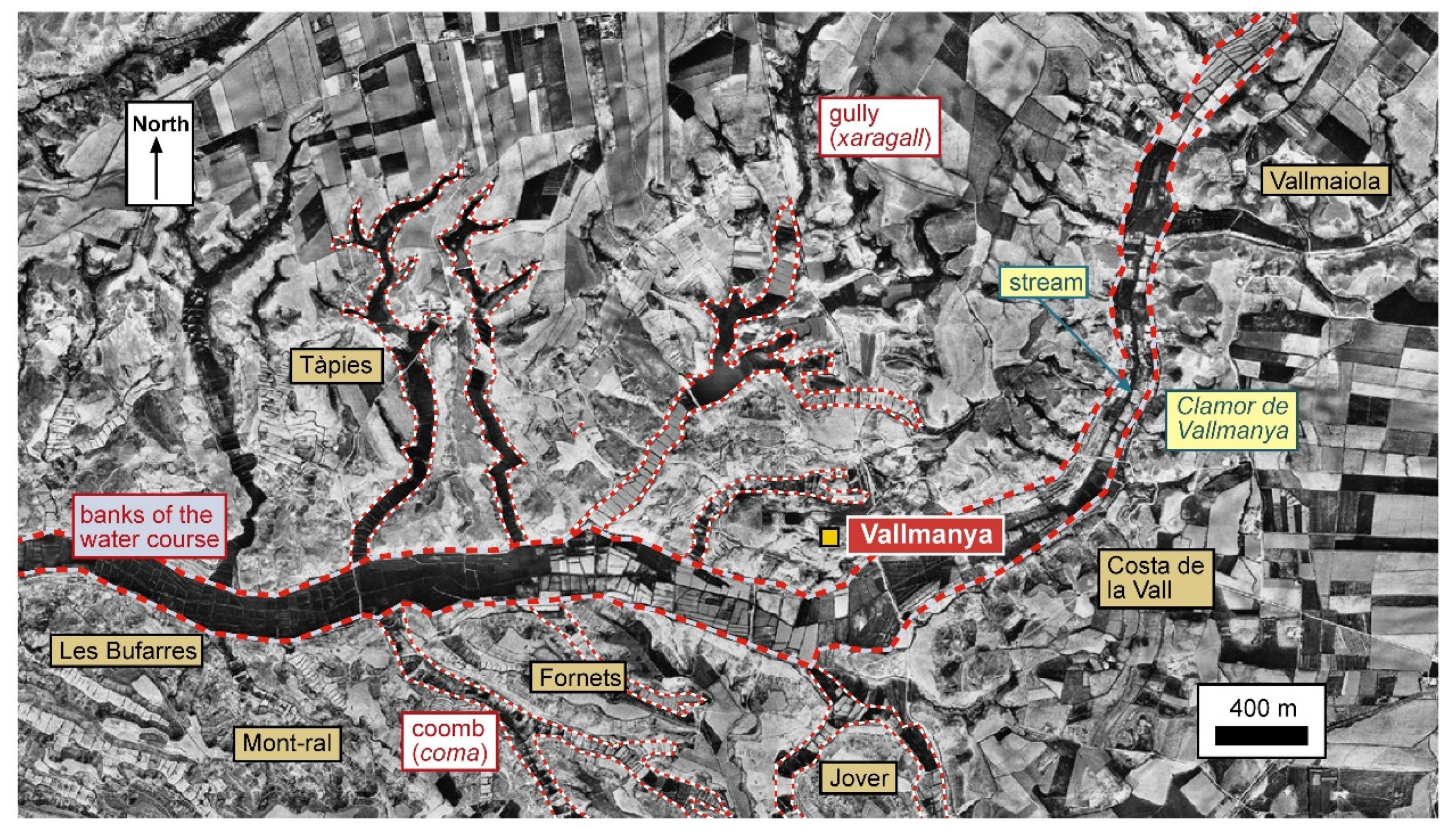
2.2.4. Other Regions
-
Sanata (Llinars del Vallès, Vallès Oriental) (Figure 14). Located north of the Via Augusta (road that in Roman times joined Barcelona and Girona) and at the foot of the Montseny mountain range, we find several coombs [38] (pp. 498–503). One of these coombs is furrowed by the Torrent de Can Diviu. It stretches for 2.3 km and covers a cultivated area of 23.6 hectares. Its width is approximately 85 m, and the elevation difference is relatively gentle compared to other cases, only about 48 m. Interestingly, there are no stone borders separating the various plots of land within this coomb. To the east of this coomb, there is another smaller one, which extends along the Torrent de Sanata. It spans about 1.2 km with an area of approximately 8 hectares. In this territory, numerous farmsteads are located not within the coomb itself but on its sides, each with its own circle of fields. The area is wooded.
-
Palou (Fonz, Aragon) (Figure 15). Situated around 3 km from the town of Fonz (known as Fonts in the Middle Ages when Catalan was spoken there), we find the small valley of Palou. It stretches for 2.1 km and covers an area of about 9.7 hectares [47]. The elevation difference in this valley is about 100 m, and its width is about 40 m. The plots of land within it range from 40 to 60 m in length. As we will discuss later, Palou is a fascinating place because its name, derived from the Latin palatiolum, possibly predates the Christian conquest and subsequent repopulation.
3. Relate the Sources to Understand the Historic Landscape
3.1. What Do the Written Documents reveal?
3.2. The Significance of Place Names
3.3. Hamlets and Villages
-
Visigoth period. Building upon the cases presented above, we would like to discuss several places where a relationship can be established between the coomb and a place that may have existed during the early medieval centuries. In Maldanell, next to the coomb, there are remains of a castle, a church dedicated to Sant Joan and a village, probably created in the 11th century. Additionally, rock-cut tombs have been discovered in close proximity to the coomb, their characteristics suggesting a dating to the sixth or seventh century [46] (pp. 95–99). The individuals buried in these graves probably lived in the vicinity and cultivated the lands of this coomb. A similar situation has been found in Comallonga. Just a few meters from Mas de Comallonga (a farmstead), there are rock-cut graves, probably from the same period as those in Maldanell, from the early medieval centuries.Furthermore, as can be seen from the information presented earlier, we can establish a connection between the site of Palou and a palatiolum during the transitional period of Late Antiquity. This fiscal domain persisted throughout the subsequent centuries. It is a place characterized by a coomb and a slope where a significant water source is found possibly directed towards the Fonz (or Fonts, springs) by the end of the Middle Ages.While it is impossible to ascertain with certainty, we must assume that during this period, many of these coombs were associated with small population centers, hamlets where several families resided. This is a subject that future archaeological excavations will need to clarify.
-
Islamic period. Cultivated coombs were already cultivated during the Islamic period. Vinfaro’s place was situated near a coomb, and Matxerri was exactly next to the strip of cultivated land. These were dryland areas, a legacy of the past prior to the eighth century. They were places where the same people who lived there before the year 713 continued to live, striking a balance between agricultural and livestock activities. In relation to Ivars’ coomb, it is important to note that a ditch was built along the Noguera Ribagorçana river, probably around the year 1000, on the left bank. The layout of the land indicates that beneath the plots created after the ditch’s construction, there were fossilized remains of the plot that we must relate to the coomb. Essentially, the layer of the Islamic channel (with its irrigated lands) was added on top of the archaeological layer of the coomb. A similar reality can be observed in other places, such as the left bank of the Cinca river, where several coombs predating the irrigated spaces near the river can be found, along with ditches created in the Islamic period or already after the Christian conquest [53].In principle, it is reasonable to assume that many of these coombs were accompanied by an almúnia or small settlement, often inherited from the inhabited places of the early medieval centuries. This is particularly evident in the case of Matxerri. Documentation sometimes mentions almúnies, while other times it refers to the presence of towers. In regions under Islamic rule, a few years before Christian conquest, towers (’abrāǧ plural of burğ) had to be constructed.Although most of the examples provided are from the region of Lleida, similar realities are found in other regions of New Catalonia. We have seen, for example, that above a coomb in Cabacés, there is a village with a name containing Arabic and Mozarabic elements, suggesting a long-standing continuity in the occupation of this place.
- Carolingian period. Settlements during the 9th and 10th centuries were mainly divided between villas (small settlements, with a church) and hamlets. It is reasonable to assume that cultivated areas were located near these population centers. Although unconfirmed, we can assume that the hamlet of a man called Arquinald was situated near Comarquinal. In La Cogullada, there was a settlement charter from the year 974 [13] (doc. 624). Several families must have settled there, near the bottom of the valley where the cultivated area extended. In the Olèrdola valley, documents mention buildings that can still be seen embedded in cliffs located on the north side of the valley. By the ninth and tenth centuries, coombs already existed and were exploited. They were attractive places, and, importantly, they were documented for the first time.
- High Middle Ages: villages and farmsteads. During the High Middle Ages, a dual process unfolded. On the one hand, certain population centers were consolidated. For instance, Ivars de Noguera, conquered in 1107, was consolidated as a village with a castle and parish church. Below the settlement, there was the coomb, which possibly housed cultivated hortes (irrigated land dedicated to cultivation). In many other locations, from the 11th–14th centuries, there was a significant increase in dispersed population. Farmstead can be found on both sides of the coombs like Can Diviu or Sanata, but they never occupied the cultivated space within the coomb [38]. In Old Catalonia, the dispersed population held great importance [6,7]. Although later and more marginal, similar patterns emerged in New Catalonia. In the Penedès region, the old village of La Cogullada was abandoned and perhaps in the 12th century, farmhouses such as Puig-sadoll, Cal Ros, Cal Garrigó or Can Ferrer were built closer to the valley bottom, leading to partial re-parcelling [54]. Around Coma de Barbó, some farmsteads were established on marginal land in relation to the fertile coomb. These farmsteads usually had their own nearby cultivated space, distinct from the bottom lands.
3.4. Irrigated Spaces
3.5. Other Plots of Land
3.6. Other Sources of Information: OSL Dating
4. Discussion
5. Conclusions
Funding
Acknowledgments
References
- Hoskins, W. G. Fieldwork in Local History, 2nd ed.; Faber and Faber: London, England, 1982.
- Aston, M. Interpreting the Landscape. Landscape Archaeology in Local Studies; B.T. Batsford, Londres, England,1985.
- Rippon, S. Historic Landscape Analysis. Deciphering the countryside; Council for British Archaeology: York, England, 2004.
- Durand, A. Les paysages médiévaux du Languedoc (xe–xiie siècles); Presses Universitaires du Mirail: Toulouse, France, 1998.
- Chouquer, G. L’étude des paysages. Essais sur leurs formes et leur histoire; Éditions Errance: París, France, 2000.
- Bolòs, J. Els orígens medievals del paisatge català. L’arqueologia del paisatge com a font per a conèixer la història de Catalunya; Institut d’Estudis Catalans and Publicacions de l’Abadia de Montserrat, Spain, 2004.
- Bolòs, J. The Historic Landscape of Catalonia. Landscape History of a Mediterranean Country in the Middle Ages; Brepols: Turnhout, Belgium, 2023.
- Abadal, R. d’. Catalunya Carolíngia, II: Els diplomes carolingis a Catalunya; Institut d’Estudis Catalans: Barcelona, Spain, 1926–1952.
- Abadal, R. d’. Catalunya Carolíngia, III: Els comtats de Pallars i Ribagorça; Institut d’Estudis Catalans: Barcelona, Spain, 1955.
- Ordeig, R. Catalunya Carolíngia, IV: Els comtats d’Osona i Manresa; Institut d’Estudis Catalans: Barcelona, Spain, 1999.
- Sobrequés, S.; Riera, S.; Rovira, M. Catalunya Carolíngia, V: Els comtats de Girona, Besalú, Empúries i Peralada; Institut d’Estudis Catalans: Barcelona, Spain, 2003.
- Ponsich, P. Catalunya Carolíngia, VI: Els comtats de Rosselló, Conflent, Vallespir i Fenollet; Institut d’Estudis Catalans: Barcelona, Spain, 2006.
- Baiges, I. J.; Puig-Ustrell, P. Catalunya Carolíngia, VII: El comtat de Barcelona; Institut d’Estudis Catalans: Barcelona, Spain, 2019.
- Ordeig, R. Catalunya Carolíngia, VIII: Els comtats d’Urgell, Cerdanya i Berga; Institut d’Estudis Catalans: Barcelona, Spain, 2020.
- Roig, J. Vilatges i assentaments pagesos de l’antiguitat tardana als territoris de Barcino i Egara (depressió litoral i prelitoral): caracterització del poblament rural entre els segles v–viii. In Actes del IV Congrés d’Arqueologia Medieval i Moderna de Catalunya; Ajuntament de Tarragona i ACRAM: Tarragona, Spain, 2011, pp. 227–250.
- Kotarba, J. Les sites d’époque wisigothique de la ligne LGV, apports et limites pour les études d’occupation du sol de la plaine du Roussillon. Domitia 2007, 8–9, 43–70.
- Bolòs, J. Cartografiar el paisatge medieval de Catalunya (segles VIII–X). Segona part: A partir dels “Atles dels comtats de la Catalunya carolíngia”. In Paisatge històric i cartografia. De l’època romana fins a l’actualitat; Bolòs, J., Ed.; Pagès Editors and Universitat de Lleida: Lleida, Spain, 2021, pp. 79–163.
- Riera, S. Evolució del paisatge vegetal holocè al Pla de Barcelona, a partir de les dades pol·líniques. Doctoral Thesis, Universitat de Barcelona, Barcelona, 1994.
- Riera, S. Evolució vegetal al sector de Vilanova-Cubelles (Garraf) en els darrers 3000 anys: processos naturals i transformacions antròpiques d’una plana litoral mediterrània”. In Territoris antics a la Mediterrània i a la Cossetània oriental; Guitard, J., Palet, J.M., Prevosti, M., Eds; Generalitat de Catalunya: Barcelona, Spain, 2003, pp. 303–312.
- Turner, S.; Bolòs, J.; Kinnaird, T. Changes and Continuities in a Mediterranean Landscape: A New Interdisciplinary Approach to Understanding Historic Character in Western Catalonia. Landscape Research 2017, 43.7, 1–17. Available online: https://doi.org/10.1080/01426397.2017.1386778. [CrossRef]
- Turner, S.; Kinnaird, T.; Varinlioğlu, G.; Emre Şerifoğlu, T.; Koparal, E.; Demirciler, V.; Athanasoulis, D.; Ødegård, K.; Crow, J.; Jackson, M.; Bolòs, J.; Sánchez-Pardo, J.C.; Carrer, F.; Sanderson, D.; Turner, A. Agricultural terraces in the Mediterranean: medieval intensification revealed by OSL profiling and dating. Antiquity 2021, 95, 773–790. Available online: https://www.cambridge.org/core/journals/antiquity/article/agricultural-terraces-in-the-mediterranean-medieval-intensification-revealed-by-osl-profiling-and-dating/09BCE89F525C6B18047ADF05400C6C47. [CrossRef]
- Coromines, J. Onomasticon Cataloniae. Els noms de lloc i noms de persona de totes les terres de llengua catalana; Curial and Caixa d’Estalvis i Pensions de Barcelona, Barcelona, Spain, 19941997. Available online: https://oncat.iec.cat/.
- Laliena, C.; Ortega, J. Arqueología y poblamiento. La Cuenca del río Martín en los siglos V–VIII; Universidad de Zaragoza: Zaragoza, Spain, 2005.
- Bolòs, J. Agua e historia del paisaje en la Corona de Aragón: distintas aproximaciones. Agua y Territorio 2023 (in press). Available online.
- Fixot, M.; Zadora-Rio, E., Eds. L’église, le terroir; Editions du CNRS: Paris, 1989.
- Catafau, A. Les celleres et la naissance du village en Roussillon (xe–xve siècles); Editorial El Trabucaire and Presses Universitaires de Perpignan: Perpinyà, France, 1998. [CrossRef]
- Creighton, O. H. Castles and Landscapes; Continuum: London, England, 2002.
- Bolòs, J. El mas, el pagès i el senyor. Paisatge i societat en una parròquia de la Garrotxa a l’edat mitjana; Curial: Barcelona, Spain, 1995.
- Bolòs, J. Ed. Un mas pirinenc medieval: Vilosiu B (Cercs, Berguedà). Estudi dels edificis i materials trobats durant les excavacions (1984-1986); Publicacions de la Universitat de Lleida: Lleida, Spain, 1996.
- Kirchner, H.; Virgili, A. Espacios agrarios en el Bajo Ebro en época andalusí y después de la conquista catalana (siglos XI–XIII). In Trigo y ovejas. El impacto de las conquistas en los paisajes andalusíes (siglos XI–XVI); Torró, J.; Guinot, E. Eds.; València (Spain): Universitat de València: València, Spain, 2018, pp. 15–49.
- Bolòs, J. Agua e historia del paisaje en Cataluña: novedades y resiliencias a lo largo de la Edad Media. El ejemplo de Lleida. Agua y Territorio 2023 (in press). Available online.
- Vita-Finzi, C. The Mediterranean Valleys. Geological Changes in Historical Times; Cambridge University Press, Cambridge, England, 1969.
- Berger, J.-F.; Brochier, J.-L. Paysages et climats en moyenne vallée du Rhône: apports de la géo-archéologie”. In Habitats, nécropoles et paysages dans la moyenne et la basse vallée du Rhône (viie–xve s.). Contribution des travaux du TGV-Méditerranée à l’étude des sociétés rurales médiévales; Maufras, O., Ed.; Maison des Sciences de l’Homme, Paris, France, 2006; pp. 163–208.
- Leeuw, S. van der; Favory, F.; Fiches, J.-L., Eds. Archéologie et systèmes socio-environnementaux. Études multiscalaires sur la vallée du Rhône dans le programme Archaeomedes; CNRS Éditions: Paris, France, 2003.
- Franceschelli, C.; Marabini, S. Lettura di un territorio sepolto. La pianura Lughese in età romana; Università di Bologna: Bologna, Italia, 2007.
- Ferret, J. L. La Formació del Delta del Llobregat (nova versió) a càrrec de Joan Lluís Ferret i Pujol; 2014. Available online: https://es.slideshare.net/amicsdelprat/la-formaci-del-delta-del-llobregat-a-crrec-de-joan-llus-ferret-i-pujol (accessed on 4 June 2023).
- Freedman, P. The Origins of Peasant Servitude in Medieval Catalonia; Cambridge University Press: Cambridge, England, 1991.
- Bolòs, J. El paisatge medieval del comtat de Barcelona: Història del paisatge, documents i cartografia d’un país mediterrani; Pagès Editors: Lleida, Spain, 2022.
- Batet, C. El castell termenat d’Olèrdola; Barcelona: Museu d’Arqueologia de Catalunya: Barcelona, Spain, 2005.
- Bolòs, J.; Urpí, R. M; Resina, J.A. (1992). “Els habitatges de Can Ximet”. In Catalunya Romànica, XIX: El Penedès. L’Anoia; Enciclopèdia Catalana: Barcelona, Spain, 1992, pp. 156–158.
- Casquete, J.; Salvadó, I. Les balmes obrades de Can Ximet (Olèrdola). Un exemple d’hàbitat troglodític a l’Edat Mitjana. In Actes del IV Congrés d’Arqueologia Medieval i Moderna de Catalunya; Ajuntament de Tarragona and ACRAM: Tarragona, Spain, 2011; pp. 855–865.
- Lladonosa, J. Història de la ciutat de Lleida; Curial Edicions: Barcelona, Spain, 1980.
- Sabaté, F. Història de Lleida, 2: Alta edat mitjana; Pagès editors, Lleida, Spain, 2003.
- Valérian, D., Ed.. Islamisation et arabisation de l’Occident musulman médiéval (VIIe-XIIe siècle); Publications de la Sorbonne: Paris, France, 2011. [CrossRef]
- Bolòs, J. L’Arqueologia del paisatge de la Catalunya medieval. Butlletí de la Societat Catalana d’Estudis Històrics 2014, 25, pp. 101–170.
- Bolòs, J. Paisatges i transicions: canvis i continuïtats al llarg de la història. In El paisatge em époques de transició al llarg dels darrers dos mil anys; Bolòs, J. Ed.; Universitat de Lleida: Lleida, Spain, 2015; pp. 95–99.
- Bolòs, J. Col·lecció diplomàtica de l’Arxiu Capitular de Lleida. Primera part: Documents de les seus episcopals de Roda i de Lleida (fins a l’any 1143); Fundació Noguera: Barcelona, Spain, 2021.
- Bolòs, J.; Hurtado, V. Atles del comtat de Barcelona (801–993); Rafael Dalmau editor: Barcelona, Spain, 2018.
- Papell, J. Diplomatari del monestir de Santa Maria de Santes Creus (975–1225); Fundació Noguera: Barcelona, Spain, 2005.
- Claramunt, S.; Bolòs, J. El capbreu de la comanda de l’Espluga de Francolí del 1558; Casal de l’Espluga de Francolí: L’Espluga de Francolí, Spain, 1991.
- Feliu, G.; Salrach, J.M., Eds. Els pergamins de l’Arxiu Comtal de Barcelona de Ramon Borrell a Ramon Berenguer I; Fundació Noguera: Barcelona, Spain, 1999.
- Brufal, J. El món rural i urbà en la Lleida islàmica (S. XI–XII): Lleida i l'est del districte: Castelldans i el pla del Mascançà; Pagès editors: Lleida, Spain, 2013.
- Bolòs, J.; Sànchez-Boira, I. Séquies i comes a la riba esquerra del Cinca. La cartografia com a eina per a l’aprenentatge i el coneixement. In Recs històrics: pagesia, història i patrimoni; Vicedo, E. Ed.; Institut d’Estudis Ilerdencs: Lleida, Spain, 2018; pp. 669–698.
- Miquel, M.; Vila, J. M. La quadra de la Cogullada. Poblament feudal a la marca del comtat de Barcelona (segles x–xiii). La Resclosa 2005, 9, 65–113.
- Regarding the creation of terraces and stone walls in some coombs near Lleida, we must mention: Boixadera, J.; Seguí, P.; Llop, J.M.; Poch, R.M. Soils on Stone-Wall Bench Terraces in Les Garrigues; Edicions de la Universitat de Lleida: Lleida, Spain, 2012.
- Rippon, S. Historic Landscape Analysis: Understanding the Past in the Present. In Detecting and Understanding Historic Landscapes; Chavarría-Arnau, A.; Reynolds, A.; Eds.; SAP Società Archaeologica: Mantova, Italy, 2015, pp. 153–172.
Disclaimer/Publisher’s Note: The statements, opinions and data contained in all publications are solely those of the individual author(s) and contributor(s) and not of MDPI and/or the editor(s). MDPI and/or the editor(s) disclaim responsibility for any injury to people or property resulting from any ideas, methods, instructions or products referred to in the content. |
© 2023 by the authors. Licensee MDPI, Basel, Switzerland. This article is an open access article distributed under the terms and conditions of the Creative Commons Attribution (CC BY) license (http://creativecommons.org/licenses/by/4.0/).
